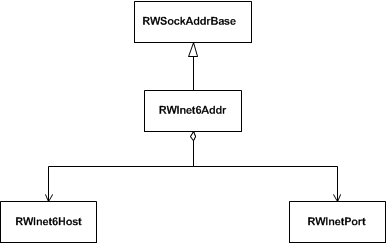Using IPv6 Addresses
IPv6 addresses represent the next generation of IP addresses. Like internet (IPv4) addresses before them, these addresses identify communication endpoints on an internet. IPv6 differs from IPv4 in the number of addressable endpoints that it can support, as well as a number of additional features that are outside of the scope of the Essential Networking Module User's Guide.
An IPv6 address is composed of three parts:
An IPv6 address is represented in the Networking package as an RWInet6Addr. As shown in Figure 11 , an RWInet6Addr object contains two objects, an RWInet6Host to represent the host, and an RWInetPort to represent the port.
Figure 11 – An RWInet6Addr object






